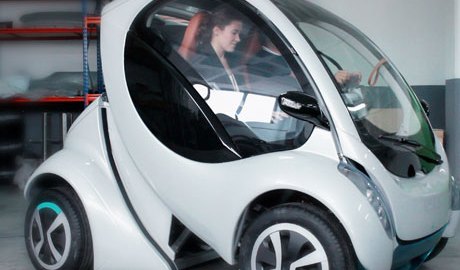The Foldable Car: Coming to a Parking Spot Near You

More than half the world’s population lives in cities, a percent that is estimated to increase to 70% by 2050. Much of the urban growth will be in the emerging economies like China and India where a new middle-class wants Western conveniences … like cars. But there are huge costs to owning and driving cars in cities: (i) cars are gas-guzzlers that pollute the environment; (ii) they are big and bulky, adding to congestion; (iii) individual ownership again leads to more congestion and air pollution. This tension between the need and unsustainability of the automobile calls for a new approach to urban mobility.
Most environmentalists agree that the best solution is for everyone to walk and cycle more and take more public transport. But let’s be honest: most people don’t like walking home from the train station after a long day’s work. They want a form of transportation that takes them right to their front door, i.e. that covers what is known as “the last mile”. Bike and car sharing schemes offer the best solution: transportation vehicles that have numerous drop-off points around the city and can be rented to take you very close to your home. This multiple use of transportation types for one journey is known as inter-modal transport. But in the case of cars, we still have two additional problems: pollution from gasoline combustion and congestion due to bulk. Cities need a micro sharableinter-modal transport that relies on renewable energy.
Enter the Hiriko. Launched last week in Brussels, the Hiriko is a micro electric car designed by MIT’s Media Lab and developed by a consortium of companies in Bilbao, Spain. Designed specifically for cities, it is a 6.5 feet, 1100 pound car that runs on two rechargeable lithium-ion batteries and can travel for 120km when fully charged. It’s meant to be part of a shared car service operated by the city, which can be rented for a small fee. The car’s computers are connected and each car can instantly be located by a smart phone. It further shrinks in size because it can be folded up (like a child’s stroller) and 3-4 Hiriko’s can fit in a standard parking space. It has an electric motor at each wheel, which means that it can move sideways into parking spots (no need for parallel parking skills). At a price of $16,000, the car has attracted interest from several cities including Barcelona, San Francisco, Berlin and Malmö.

European Commission president Jose Manuel Barroso attends the international presentation of the first self-folding electric vehicle, Hiriko, at the EU headquarters in Brussels January 24, 2012.(Yves Herman/Reuters)
The Hiriko represents, at least philosophically, the right idea in future urban mobility. The car’s concept was developed in the MIT department once run by William Mitchell. The group came up with a set of principles and techniques that could be theoretically applied to any mode of transportation. The book Reinventing the Automobile for the 21st Century is definitely worth a read (for a quick overview, see this slideshow by Fast Company). But the car as it stands now has its critics. The Economist said it was full of “sexy gimmicks” and German newspapers have recently wondered whether electric mobility that doesn’t rely on renewable energy might actually worsen climate change. It’s true: electric mobility is a “smart” city infrastructure innovation that relies on more than just the design of the car. The future urban mobility platform requires involvement from public transport agencies, private car manufacturers, alternative energy providers, charging station vendors, ICT experts, universities, and citizens (whose needs must be understood, and whose behavior must be coaxed to change). It is worth noting that the Hiriko is not the first micro smart car on the market and all previous ones have failed to attract a large consumer base (Smart, the compact car by Daimler, has sold under a million units in the last ten years).
It might seem gimmicky, but we think such exploration and experimentation is a positive step – or drive – in the right direction.
Ayesha and Parag Khanna are Directors of the Hybrid Reality Institute, a research and advisory group focused on human-technology co-evolution, geotechnology and translating invention into innovation.




